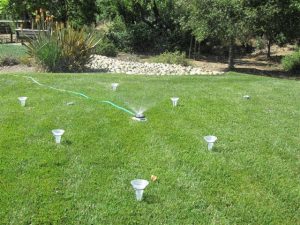All you need for a drip system is a few parts to hook up to your hose faucet and voilà, a water-saving, instant watering system. While it does work and I have used systems like that on a temporary basis, it is pretty limited. For a patio or a small yard, it is the way to go. You can vary the amount of water per plant by adding more and/or larger emitters to create a system that will handle everything from pansies to fruit trees. The problem is that your trees will develop shallow root systems and your pansies will drown. I shudder to think what this system will do to California native plants.
A landscaped yard with a garden and mini orchard needs a much more complicated drip system than many commercial systems, in terms of the number of zones. A simple way to define a zone is to think of it as either a geographic area or a group of plants that have similar watering needs. The size of a zone is limited by distance and water capacity. For example, a half-inch drip hose will deliver water for 200 feet and at 200 gallons per hour. That is 400 half-gallon/hour emitters. It is tempting to just stretch out a hose and start punching in emitters and in fact, that is what most homeowners do.
Dividing your landscape into water-need zones is a way to get healthier plants and save water. Trees, for example, need deep watering to encourage them to form deeper root systems by letting the water near the surface dry out in between watering. This also discourages a lot of types of weeds.
A vegetable garden, however, needs consistent watering that will maintain a moist, but not wet, soil. You need very different watering schedules to make this happen. Putting a large amount of water once a week on the trees, and much smaller amounts every other day on my raised beds will do this, so it is easy to see why these need to be in different zones. Because of this, I often have two or more similar zones covering the same geographic area to serve plants with differing water needs. Some types of zones are small but need a valve of their own.
For example, my wife’s patio plants. Ten minutes every other day will handle hanging baskets and potted plants without running water all over the place. Any other zone I have would overfill the pots every time I water. Some zones are redundant. For example, I have a tree zone in the front yard as well as one in the back yard. A half-inch drip tube only runs 200 feet, so to do both would make the lines too long. I could use a larger tube, but I prefer to just use one size so I don’t need to carry a lot of repair parts, and drip systems do require inspection and maintenance.
We bury our half-inch lines under a couple inches of dirt and the quarter-inch lines hide in the mulch. It makes the whole yard look better. Before you ask though, yes, I have hit them with a shovel, but they are easy to repair. Shove in a coupling and the system is ready to go. It doesn’t happen too often though, I kind of remember where they are, especially after I have hit them once.
Obviously, you can’t control this kind of system with battery-operated hose timers and a splitter off your hose bib. My system is controlled by a sprinkler timer and anti-siphon valves on a PVC manifold just like lawn sprinklers. Incidentally, you can use a sub-surface drip system to water grass, but living in the foothills of California, I let what little grass I have go brown in the summer and save my water for other things.
Jim Bliss is a University of California Cooperative Extension Master Gardener of Tuolumne County.
UCCE Master Gardeners of Tuolumne and Calaveras Counties can answer home gardening questions. Call 209-533-5912 or fill out our easy-to-use problem questionnaire here. Check out our website here. You can also find us on Facebook.

